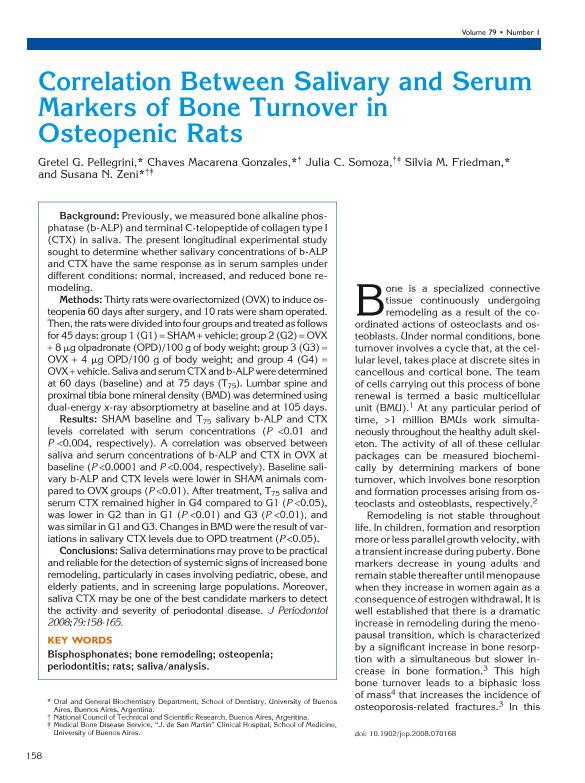Artículo
Correlation between salivary and serum markers of bone turnover in osteopenic rats
Pellegrini, Gretel Gisela ; Gonzales Chaves, Macarena Maria Sol
; Gonzales Chaves, Macarena Maria Sol ; Somoza, Julia Isabel
; Somoza, Julia Isabel ; Friedman, Silvia María; Zeni, Susana Noemi
; Friedman, Silvia María; Zeni, Susana Noemi
 ; Gonzales Chaves, Macarena Maria Sol
; Gonzales Chaves, Macarena Maria Sol ; Somoza, Julia Isabel
; Somoza, Julia Isabel ; Friedman, Silvia María; Zeni, Susana Noemi
; Friedman, Silvia María; Zeni, Susana Noemi
Fecha de publicación:
01/2008
Editorial:
American Academy of Periodontology
Revista:
Journal of Periodontology
ISSN:
0022-3492
Idioma:
Inglés
Tipo de recurso:
Artículo publicado
Clasificación temática:
Resumen
Background: Previously, we measured bone alkaline phosphatase (b-ALP) and terminal C-telopeptide of collagen type I (CTX) in saliva. The present longitudinal experimental study sought to determine whether salivary concentrations of b-ALP and CTX have the same response as in serum samples under different conditions: normal, increased, and reduced bone remodeling. Methods: Thirty rats were ovariectomized (OVX) to induce osteopenia 60 days after surgery, and 10 rats were sham operated. Then, the rats were divided into four groups and treated as follows for 45 days: group 1 (G1) = SHAM + vehicle; group 2 (G2) = OVX + 8 μg olpadronate (OPD)/100 g of body weight; group 3 (G3) = OVX + 4 μg OPD/100 g of body weight; and group 4 (G4) = OVX + vehicle. Saliva and serum CTX and b-ALP were determined at 60 days (baseline) and at 75 days (T75). Lumbar spine and proximal tibia bone mineral density (BMD) was determined using dual-energy x-ray absorptiometry at baseline and at 105 days. Results: SHAM baseline and T75 salivary b-ALP and CTX levels correlated with serum concentrations (P <0.01 and P <0.004, respectively). A correlation was observed between saliva and serum concentrations of b-ALP and CTX in OVX at baseline (P<0.0001 and P<0.004, respectively). Baseline salivary b-ALP and CTX levels were lower in SHAM animals compared to OVX groups (P<0.01). After treatment, T75 saliva and serum CTX remained higher in G4 compared to G1 (P<0.05), was lower in G2 than in G1 (P<0.01) and G3 (P<0.01), and was similar in G1 and G3. Changes in BMD were the result of variations in salivary CTX levels due to OPD treatment (P<0.05). Conclusions: Saliva determinations may prove to be practical and reliable for the detection of systemic signs of increased bone remodeling, particularly in cases involving pediatric, obese, and elderly patients, and in screening large populations. Moreover, saliva CTX may be one of the best candidate markers to detect the activity and severity of periodontal disease.
Palabras clave:
BISPHOSPHONATES
,
BONE REMODELING
,
OSTEOPENIA
,
PERIODONTITIS
,
RATS
,
SALIVA/ANALYSIS
Archivos asociados
Licencia
Identificadores
Colecciones
Articulos(INIGEM)
Articulos de INSTITUTO DE INMUNOLOGIA, GENETICA Y METABOLISMO
Articulos de INSTITUTO DE INMUNOLOGIA, GENETICA Y METABOLISMO
Articulos(OCA HOUSSAY)
Articulos de OFICINA DE COORDINACION ADMINISTRATIVA HOUSSAY
Articulos de OFICINA DE COORDINACION ADMINISTRATIVA HOUSSAY
Citación
Pellegrini, Gretel Gisela; Gonzales Chaves, Macarena Maria Sol; Somoza, Julia Isabel; Friedman, Silvia María; Zeni, Susana Noemi; Correlation between salivary and serum markers of bone turnover in osteopenic rats; American Academy of Periodontology; Journal of Periodontology; 79; 1; 1-2008; 158-165
Compartir
Altmétricas



